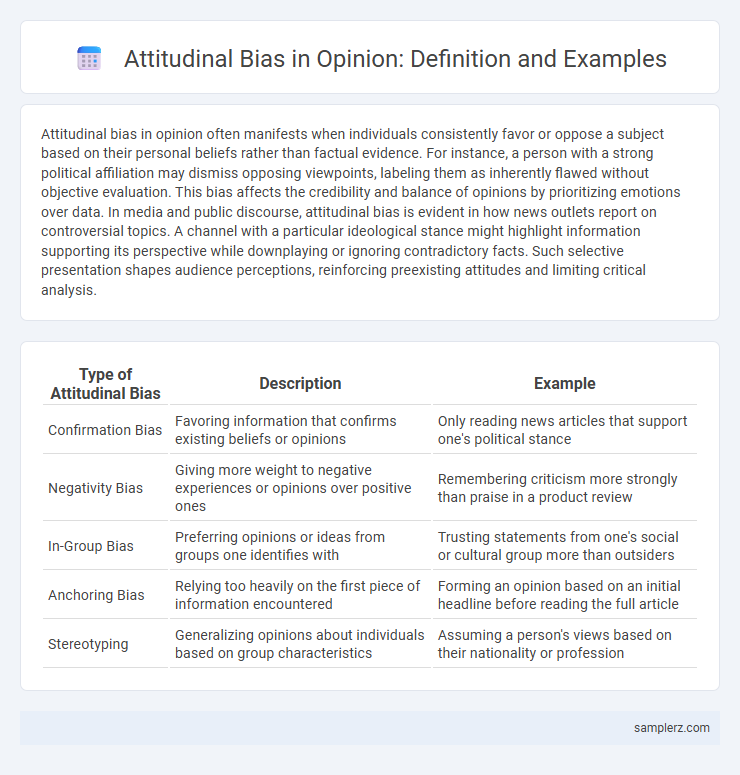Attitudinal bias in opinion often manifests when individuals consistently favor or oppose a subject based on their personal beliefs rather than factual evidence. For instance, a person with a strong political affiliation may dismiss opposing viewpoints, labeling them as inherently flawed without objective evaluation. This bias affects the credibility and balance of opinions by prioritizing emotions over data. In media and public discourse, attitudinal bias is evident in how news outlets report on controversial topics. A channel with a particular ideological stance might highlight information supporting its perspective while downplaying or ignoring contradictory facts. Such selective presentation shapes audience perceptions, reinforcing preexisting attitudes and limiting critical analysis.
Table of Comparison
| Type of Attitudinal Bias | Description | Example |
|---|---|---|
| Confirmation Bias | Favoring information that confirms existing beliefs or opinions | Only reading news articles that support one's political stance |
| Negativity Bias | Giving more weight to negative experiences or opinions over positive ones | Remembering criticism more strongly than praise in a product review |
| In-Group Bias | Preferring opinions or ideas from groups one identifies with | Trusting statements from one's social or cultural group more than outsiders |
| Anchoring Bias | Relying too heavily on the first piece of information encountered | Forming an opinion based on an initial headline before reading the full article |
| Stereotyping | Generalizing opinions about individuals based on group characteristics | Assuming a person's views based on their nationality or profession |
Recognizing Attitudinal Bias in Opinion Writing
Attitudinal bias in opinion writing often emerges through language that reveals a writer's emotions or subjective judgments rather than objective facts, such as using loaded words or exaggerated claims. Recognizing this bias involves critically assessing the choice of adjectives, adverbs, and tone that may skew the reader's perception and undermine balanced argumentation. Identifying attitudinal bias enhances readers' ability to discern persuasive intent and maintain a more nuanced understanding of the topic.
Common Attitudinal Biases That Shape Perspectives
Confirmation bias strongly influences opinions by leading individuals to favor information that supports their preexisting beliefs while dismissing contradictory evidence. Overconfidence bias causes people to overestimate the accuracy of their judgments, reinforcing subjective viewpoints without adequate scrutiny. These common attitudinal biases significantly shape perspectives, distorting objective assessment and fostering polarized opinions.
How Personal Beliefs Distort Objective Opinion
Attitudinal bias often manifests when personal beliefs overshadow factual evidence, leading to subjective interpretations of information. This distortion occurs as individuals selectively accept data that aligns with their values while dismissing contradictory facts, undermining objective opinion formation. Research indicates that deeply held beliefs trigger cognitive biases such as confirmation bias, which impairs critical thinking and reinforces skewed perspectives.
Subtle Signs of Attitudinal Bias in Editorials
Editorials often reveal attitudinal bias through selective language that subtly frames subjects in a positive or negative light, shaping readers' perceptions without overt statements. The use of emotionally charged adjectives, strategic omission of counterarguments, and privileging of specific narratives demonstrate a preference that aligns with the author's underlying beliefs. These nuanced techniques influence public opinion by embedding partiality within seemingly objective analysis.
Examples of Attitudinal Bias in Media Opinions
Media opinions often display attitudinal bias through selective framing of information that reinforces the outlet's ideological stance, such as conservative outlets emphasizing economic skepticism while liberal ones highlight social justice issues. Confirmation bias is prevalent when commentators consistently interpret events to support their pre-existing beliefs, neglecting contrary evidence. Another example is emotional bias, where media narratives invoke fear or optimism to sway audience attitudes toward political figures or policies.
The Role of Confirmation Bias in Opinion Formation
Confirmation bias significantly shapes opinion formation by prompting individuals to seek and favor information that reinforces their pre-existing beliefs, often disregarding contradictory evidence. This attitudinal bias manifests in selective exposure to news sources, social media echo chambers, and cognitive dismissal of opposing viewpoints, thereby entrenching polarized perspectives. The neurocognitive mechanisms underlying this bias enhance emotional resonance with agreeable information, making objective reassessment of opinions challenging.
Impact of Attitudinal Bias on Public Discourse
Attitudinal bias in opinion shapes public discourse by distorting how information is perceived and discussed, leading to polarized debates and reinforcing echo chambers. This bias limits exposure to diverse perspectives, undermining critical thinking and constructive dialogue essential for democratic decision-making. Recognizing and addressing attitudinal bias is crucial to fostering informed, balanced conversations in media and politics.
Overcoming Attitudinal Bias in Expressing Views
Overcoming attitudinal bias in expressing views requires conscious self-reflection to identify and acknowledge personal prejudices that distort judgment. Employing techniques such as perspective-taking and seeking diverse sources of information enhances objectivity and reduces emotional influence on opinions. Engaging in open dialogues with differing viewpoints fosters critical thinking and cultivates balanced, unbiased expressions of attitudes.
Case Studies: Attitudinal Bias in Social Debates
Case studies on attitudinal bias in social debates reveal how personal beliefs and emotions shape individuals' interpretations of facts, often leading to polarized perspectives on issues like climate change and immigration. These biases manifest through selective exposure to information, confirmation bias, and emotive language, which reinforce pre-existing attitudes and hinder objective discourse. Understanding the mechanisms of attitudinal bias is crucial for developing strategies to foster open-mindedness and constructive dialogue in contentious social debates.
Strategies to Minimize Attitudinal Bias in Opinion Pieces
Attitudinal bias in opinion pieces often manifests through selective evidence presentation and emotionally charged language that skews reader perception. Implementing strategies such as incorporating diverse viewpoints, fact-checking assertions, and maintaining neutral tone can significantly reduce this bias. Employing these techniques enhances credibility and promotes balanced discourse in journalistic and editorial writing.

example of attitudinal bias in opinion Infographic
 samplerz.com
samplerz.com